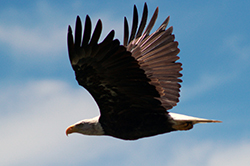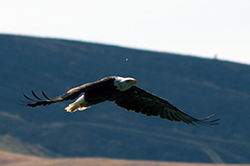Once on the verge of extinction in the lower 48 states, the bald eagle (Haliaeetus leucocephalus) has made a remarkable comeback in California. Management programs and protective laws (most notably, a ban on the pesticide DDT) have had a profoundly positive effect on both the reproductive success and survival rate of the species. Its breeding range is rapidly expanding and today, bald eagles can be found in 42 of California’s 58 counties, rebounding from a low of eight counties in the mid-1990s.


Once on the verge of extinction in the lower 48 states, the bald eagle (Haliaeetus leucocephalus) has made a remarkable comeback in California. Management programs and protective laws (most notably, a ban on the pesticide DDT) have had a profoundly positive effect on both the reproductive success and survival rate of the species. Its breeding range is rapidly expanding and today, bald eagles can be found in 42 of California’s 58 counties, rebounding from a low of eight counties in the mid-1990s.
Though the U.S. Fish and Wildlife Service removed the bald eagle from its list of threatened and endangered species in 2007, the species remains endangered under California state law, and data is constantly being gathered and analyzed to support ongoing population recovery efforts. But studying California’s eagle population is more difficult than one might think. Although reports of single eagle sightings are a useful tool for determining range expansion, they are often inconsistent and inappropriate for estimating the overall population. A better method is documenting bald eagle observations and breeding territories and monitoring them over time. To do that, CDFW relies heavily on survey data submitted by other agency partners, researchers, consultants and the general public.
According to CDFW’s Statewide Raptor Coordinator Carie Battistone, there are two ways for members of the public to contribute to this important database.
Single observations can be reported using the California Natural Diversity Data Base (CNDDB) Online Field Survey Form. This may include breeding (for example, a nest location or a pair constructing a nest) or nonbreeding (a single bird foraging or perched) observations. For all data submissions, the more information that is provided to the CNDDB on population size, site condition, threats, etc., the better.
People who have more time (or experience in long-term monitoring) should use the  Bald Eagle Nesting Territory Survey Form (PDF). This form is typically used by observers who monitor a nest frequently during an entire breeding season (from when a pair arrives at or builds a nest to when the young fledge). The information recorded on this form allows CDFW to determine nest success and productivity. Observers take notes during each survey they conduct, including behavior, the number of adults and young seen, number of fledglings, predation events, nest conditions, etc. Observers should closely follow the survey instructions and keep their distance from the eagles so as to not disturb breeding activities.
Bald Eagle Nesting Territory Survey Form (PDF). This form is typically used by observers who monitor a nest frequently during an entire breeding season (from when a pair arrives at or builds a nest to when the young fledge). The information recorded on this form allows CDFW to determine nest success and productivity. Observers take notes during each survey they conduct, including behavior, the number of adults and young seen, number of fledglings, predation events, nest conditions, etc. Observers should closely follow the survey instructions and keep their distance from the eagles so as to not disturb breeding activities.
Various other types of data are tracked in CDFW’s databases, including the coordinates of observation or nest location, land ownership, the number of nests within a territory, the nest-tree type and nest condition, the number of surveys at a territory or nest, the number of adults or sub-adults seen, the number of eggs laid, the number of young fledged, predation events associated with an observation, general behavior, and other pertinent information.
“The more information we have on nest location, behaviors and breeding activities, the easier it is for us to decipher how eagles are using their territory and what the status is at any given site,” said Battistone.
According to Battistone, 371 nest sites have been reported and entered in CDFW’s bald eagle database to date (early 1990s through 2016). This data, however, is incomplete -- not all nests are reported or known, and of the nests that are entered in the database not all are surveyed every year.
CDFW receives regular reports of bald eagle sightings throughout the state during both the breeding and nonbreeding season, and as the population continues to grow and expand it is expected the number of sightings will continue to increase.
“Because the bald eagle population seems to be increasing in California, reports of new nests are not entirely surprising,” Battistone said. “However, to get a better understanding of the extent of the population increase and expansion throughout different regions of California, it is helpful to have the most complete dataset possible. We encourage and appreciate participation from the public!”
Bald eagle photos used with permission, courtesy of Marcia Grefsrud.